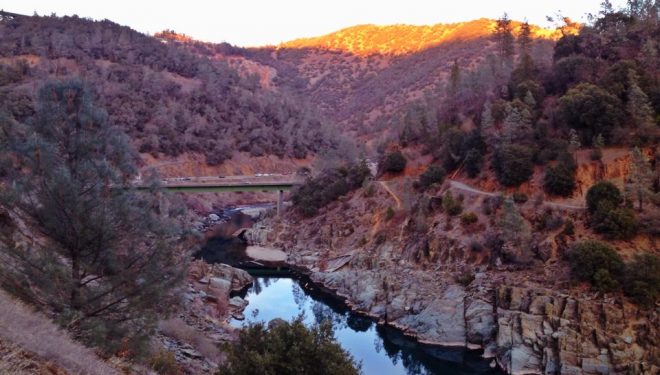
By Lauren Hoover and John Sittler
In 2026, a host of agreements that provide guidelines on managing the Colorado River are set to expire. To prepare for this, the Upper and Lower Colorado River Basin states submitted separate proposals for the Bureau of Reclamation to consider. Both basins agree that the Colorado River is the most vital resource for supporting the forty million—and growing—Americans reliant on the river. Despite the two basins having the same goal of conserving this resource, the proposals are at odds with each other in one detail. Particularly, each basin argues that the other should bear the burden of reducing diversions during times of shortage.
Background
The Colorado River Compact was enacted in 1922 to divide the river’s flows between the “Upper Basin” (Colorado, Utah, Wyoming, New Mexico) and the “Lower Basin” (Nevada, Arizona, California). The agreement was based on approximately 30 years of streamflow records suggesting an average annual flow of 17.5 million acre-feet (maf) past Lee’s Ferry, the historical divider between the Upper and Lower Basins. With these assumptions in mind, the Upper Basin agreed to deliver the Lower Basin an average of 7.5 maf per year (measured as 75 maf every ten years) at Lee’s Ferry. However, recent studies suggest that those years were some of the wettest years in observational history, and the average flow hovers closer to 13 maf per year. This means the river is already over-allocated, and recent trends of drought and climate change only exacerbate the river’s decreasing volume.
The Lower Basin benefits from both Lake Mead and Lake Powell, which act as water banks that store water during wetter periods so that during drier periods, water can be released into the river for the Lower Basin’s use. Because of Powell and Mead, there is a more consistent water supply for the Lower Basin during times of low river flows and drought. On the other hand, the Upper Basin relies on that year’s snowmelt to provide flows, which can be less steady or predictable. But this operation also means that both lakes have dropped significantly over the last decade as more water is released to the Lower Basin than inflows from the Upper Basin. Lake Powell, in particular, has flirted with the elevations that trigger short sharing rules and potentially impact the ability of Glen Canyon Dam to produce hydropower.
Since 2000, the western United States has experienced some of the driest decades in observational history. Lake Powell dropped to only one-third of its capacity in 2005, and by 2010, Lake Mead was approaching the “drought trigger” level, which is the predetermined level that triggers the Bureau of Reclamation to enforce water rationing in Arizona and Nevada. These low levels caused tensions between states and the basins, resulting in the Bureau establishing the 2007 Interim Guidelines. This protocol was in place from 2008 until December 31, 2015, and regulated how water in Lake Powell and Lake Mead was allocated depending on reservoir levels. The 2007 Interim Guidelines were intended as longer-term plans with the opportunity to reevaluate in 2026. However, increased drought and dropping reservoir levels resulted in the 2019 Drought Contingency Plans. These plans were enacted to similarly regulate water allocation to protect the river and reservoir levels, specifically in an attempt to reduce the risk of reaching “critical levels” in Lake Powell while still ensuring compliance with the original Colorado River Compact. Even with both shortage-sharing programs in place, the megadrought continues throughout the west, further stretching each reservoir and threatening Colorado River Compact stability. With both protocols set to expire, the Bureau of Reclamation requested proposals from the basin states to regulate water distribution under the Compact.
2024 Proposals
The U.S. Bureau of Reclamation requested the proposals by March 11, 2024 so that the Bureau has time to prepare an environmental impact statement (EIS) under the National Environmental Policy Act (NEPA) and make a decision before 2026. The Bureau plans to release a draft EIS by the end of 2024 which will assess the proposals and other alternatives for operational plans on the river.
The Bureau originally directed the states to work together to submit a unified proposal. However, conflict and disagreement between the Upper and Lower Basins quickly became apparent and each basin agreed to work cooperatively amongst itself to submit two separate proposals to the Bureau.
Upper Basin Proposal
The Upper Basin’s proposal calls for operations of Lake Powell to be aligned with actual hydrologic conditions, as opposed to models and predictions. Per the Upper Basin, the releases from Lake Powell should depend on the actual capacity of the reservoir. Simply, the lower the level, the less that the Lower Basin should be releasing. The proposal also calls for the Lower Basin to reduce diversions from Lake Mead to preserve its storage. The Upper Basin’s focus is on the Lower Basin and imposing mandatory conservation efforts, with only incentives for voluntary reductions in the Upper Basin. Releases based on snowpack and inflows would relieve the Upper Basin from the Colorado River Compact burden of delivering the same 7.5 maf per year, regardless of how much water is actually in the river. This proposal relies on the fact that the Upper Basin believes it is well below its Compact allotments. Thus, the Lower Basin should bear the majority of cutbacks during drought conditions.
Lower Basin Proposal
The Lower Basin’s post-2026 operational guidelines apply a self-described “holistic” approach to managing river operations. The Lower Basin first acknowledges that at least 1.3 maf are lost each year to evaporation and seepage, also referred to as the “structural deficit.” Climate change and continuing aridification are expected to worsen these losses. To offset the structural deficit, the plan proposes a voluntary cut of 1.5 maf per year for the Lower Basin. The Lower Basin proposal also focuses on managing diversions in accordance with levels in the reservoirs. Based on the reservoir volumes, the plan delineates conservation efforts for both basins.
Bearing the Burden of Diversion Reductions
The main difference between the Upper and Lower Basin proposals is the issue of who bears the burden of reducing diversion in times of shortage. The Upper Basin contends that it has conserved as much water as practicable and that it should be primarily up to the Lower Basin to make meaningful reductions. Under the original Compact, the Lower Basin is entitled to receive an average of 7.5 maf per year. Meaning, in times when the river’s flow is less than 15 maf (or more, when accounting for Mexico’s allotment under the Compact), which is becoming more common because of climate change and the megadrought, the Upper Basin receives less than half of the river’s flow. Because the Upper Basin must ensure that the Lower Basin gets its 7.5 maf, the Upper Basin argues that it cannot continue to make reductions and the Lower Basin needs to do more to conserve the river’s flows. Further, the Upper Basin states do not have comparable reservoirs like Lake Mead or Lake Powell to stabilize supply in times of shortage. Instead, these states rely on that year’s snowmelt for water supply. But the Lower Basin argues that it has more people living in its Basin and everyone reliant on the river—which is 40 million people between both basins—needs to make sacrifices.
Conclusion and Implications
If the states do not agree on a unified plan the federal government, through the Bureau, could step in and devise its own protocol to divide the Colorado River. The probability of either basin viewing the Bureau’s plan as unfavorable runs the risk of potential litigation, which, if it resembles the Arizona v. California cases—one of the longest-running series of water rights disputes beginning in 1952 and continuing to 2000—means it could be a long time before there is an agreement. A long-term legal dispute is not in the interest of either Basin as the effects of climate change and the megadrought will continue without regard to whether a final agreement has been reached. Thus, a management plan must be enacted, at least temporarily, while the Basins and the Bureau work towards a long-term solution.
Without any plan in place, if the Upper Basin could not deliver 7.5 maf to the Lower Basin, then the Lower Basin could potentially put forth a “compact call.” A compact call would require the Upper Basin to curtail its water use to ensure that the Lower Basin is receiving its allocated amount under the Compact. A compact call has never occurred before. But if there is no management plan in place, and states and the federal government are intertwined in a long-term legal dispute, then this could be a last-ditch effort for the Lower Basin to ensure it is getting its allocated amounts under the Compact. A compact call would in itself no doubt result in messy and protracted litigation. If the conflicting opinions on who should bear the burden in times of shortage in the 2024 proposals are any indication of the contention between the Basins, litigation would not be in the best interest of maintaining good relations between each state, despite the strong, shared interest of protecting this resource.
Balancing the competing interests and justifications for each Basin will indeed prove difficult. But without an agreement, all seven basin states continue to gamble with their most valuable resource, a risk that neither Basin seems willing to accept.



